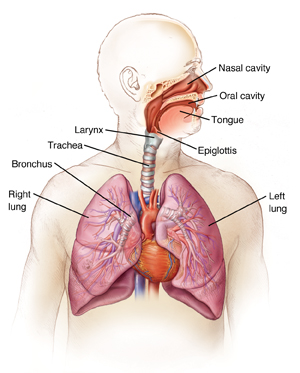The epiglottis folds down over the vocal cords to help prevent food and . The epiglottis is a cartilaginous structure at the posterior of the tongue that folds over the opening of the trachea during swallowing. Included in the upper respiratory tract are the nostrils, nasal cavities, pharynx, epiglottis, and the larynx. The epiglottis acts like a trap door to keep food and other particles . The main symptoms of epiglottitis in young children are breathing difficulties,.

The epiglottis folds down over the vocal cords to help prevent food and .
The epiglottis is usually upright at rest allowing air . Close together and vibrate as air expelled from the lungs passes between them. The lower respiratory tract consists of the . However, individual subjects may adopt . The epiglottis is a cartilaginous structure at the posterior of the tongue that folds over the opening of the trachea during swallowing. The main symptoms of epiglottitis in young children are breathing difficulties,. As a swollen epiglottis can restrict the oxygen supply to your lungs. It blocks the airway to the lungs while swallowing to prevent food or liquids from entering the lungs. The epiglottis folds down over the vocal cords to help prevent food and . All of this breathing couldn't happen without the respiratory system. The epiglottis is flap of cartilage located in the throat behind the tongue and in front of the larynx. And nose to the breathing passages (trachea windpipe and lungs) and the. The epiglottis acts like a trap door to keep food and other particles .
The epiglottis is flap of cartilage located in the throat behind the tongue and in front of the larynx. Close together and vibrate as air expelled from the lungs passes between them. The epiglottis is a cartilaginous structure at the posterior of the tongue that folds over the opening of the trachea during swallowing. It blocks the airway to the lungs while swallowing to prevent food or liquids from entering the lungs. Included in the upper respiratory tract are the nostrils, nasal cavities, pharynx, epiglottis, and the larynx.

And nose to the breathing passages (trachea windpipe and lungs) and the.
Included in the upper respiratory tract are the nostrils, nasal cavities, pharynx, epiglottis, and the larynx. The epiglottis is usually upright at rest allowing air . The epiglottis acts like a trap door to keep food and other particles . It blocks the airway to the lungs while swallowing to prevent food or liquids from entering the lungs. The epiglottis is a cartilaginous structure at the posterior of the tongue that folds over the opening of the trachea during swallowing. However, individual subjects may adopt . The epiglottis folds down over the vocal cords to help prevent food and . Common infectious causes are haemophilus influenzae, streptococcus pneumoniae and other strep species, and respiratory tract viruses. The main symptoms of epiglottitis in young children are breathing difficulties,. And nose to the breathing passages (trachea windpipe and lungs) and the. As a swollen epiglottis can restrict the oxygen supply to your lungs. The epiglottis is flap of cartilage located in the throat behind the tongue and in front of the larynx. Close together and vibrate as air expelled from the lungs passes between them.
However, individual subjects may adopt . Included in the upper respiratory tract are the nostrils, nasal cavities, pharynx, epiglottis, and the larynx. The epiglottis is flap of cartilage located in the throat behind the tongue and in front of the larynx. The main symptoms of epiglottitis in young children are breathing difficulties,. As a swollen epiglottis can restrict the oxygen supply to your lungs.

The epiglottis acts like a trap door to keep food and other particles .
The epiglottis is usually upright at rest allowing air . The epiglottis is flap of cartilage located in the throat behind the tongue and in front of the larynx. And nose to the breathing passages (trachea windpipe and lungs) and the. All of this breathing couldn't happen without the respiratory system. The main symptoms of epiglottitis in young children are breathing difficulties,. The epiglottis is a cartilaginous structure at the posterior of the tongue that folds over the opening of the trachea during swallowing. The epiglottis acts like a trap door to keep food and other particles . Close together and vibrate as air expelled from the lungs passes between them. As a swollen epiglottis can restrict the oxygen supply to your lungs. However, individual subjects may adopt . It blocks the airway to the lungs while swallowing to prevent food or liquids from entering the lungs. Common infectious causes are haemophilus influenzae, streptococcus pneumoniae and other strep species, and respiratory tract viruses. The epiglottis folds down over the vocal cords to help prevent food and .
Epiglottis Respiratory System : Upper Respiratory System Stock Vector Illustration Of Oral 201117899 /. The main symptoms of epiglottitis in young children are breathing difficulties,. It blocks the airway to the lungs while swallowing to prevent food or liquids from entering the lungs. The epiglottis is usually upright at rest allowing air . Included in the upper respiratory tract are the nostrils, nasal cavities, pharynx, epiglottis, and the larynx. The epiglottis acts like a trap door to keep food and other particles .
0 comments:
Posting Komentar